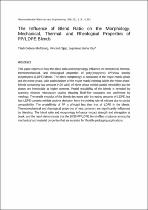 ResearchSpace
ResearchSpace
The influence of blend ratio on the morphology, mechanical, thermal, and rheological properties of PP/LDPE blends
JavaScript is disabled for your browser. Some features of this site may not work without it.
- ResearchSpace
- →
- Research Publications/Outputs
- →
- Journal Articles
- →
- View Item
| dc.contributor.author |
Mofokeng, Tladi G

|
|
| dc.contributor.author |
Ojijo, Vincent O

|
|
| dc.contributor.author |
Ray, Suprakas S

|
|
| dc.date.accessioned | 2017-02-23T09:59:33Z | |
| dc.date.available | 2017-02-23T09:59:33Z | |
| dc.date.issued | 2016-10 | |
| dc.identifier.citation | Mofokeng, T.G., Ojijo, V. and Ray, S.S. 2016. The influence of blend ratio on the morphology, mechanical, thermal, and rheological properties of PP/LDPE blends. Macromolecular Materials and Engineering, 301(10), pp 1191–1201 | en_US |
| dc.identifier.issn | 1438-7492 | |
| dc.identifier.uri | http://onlinelibrary.wiley.com/doi/10.1002/mame.201600166/abstract | |
| dc.identifier.uri | http://hdl.handle.net/10204/8946 | |
| dc.description | Copyright: 2016 Wiley-VCH Verlag. Due to copyright restrictions, the attached PDF file only contains the abstract of the full text item. For access to the full text item, please consult the publisher's website. The definitive version of the work is published in the Macromolecular Materials and Engineering, 301(10), pp 1191–1201 | en_US |
| dc.description.abstract | This paper reports on how the blend ratio and morphology influence the mechanical, thermal, thermomechanical, and rheological properties of poly(propylene) (PP)/low density polyethylene (LDPE) blends. The blend morphology is composed of the major matrix phase and the minor phase, with subinclusions of the major matrix existing within the minor phase. Blends containing low amounts (<20 wt%) of either phase exhibit partial miscibility but the phases are immiscible at higher contents. Partial miscibility of the blends is revealed by scanning electron microscopy studies showing fibril-like structures and confirmed by rheology. The tensile modulus of the blends decreases with increasing amounts of LDPE, but low LDPE contents exhibit positive deviation from the mixing rule of mixture due to partial compatibility. The crystallinity of PP is affected less than that of LDPE in the blends. Thermomechanical and rheological properties of neat polymers are significantly influenced by blending. The blend ratio and morphology influence impact strength and elongation at break, and the result demonstrates that the 80/20 PP/LDPE blend offers a balance among the mechanical and material properties that are essential for flexible packaging applications. | en_US |
| dc.language.iso | en | en_US |
| dc.publisher | Wiley | en_US |
| dc.relation.ispartofseries | Wokflow;17679 | |
| dc.subject | PP/LDPE blends | en_US |
| dc.subject | Polymer blends | en_US |
| dc.title | The influence of blend ratio on the morphology, mechanical, thermal, and rheological properties of PP/LDPE blends | en_US |
| dc.type | Article | en_US |
| dc.identifier.apacitation | Mofokeng, T. G., Ojijo, V. O., & Ray, S. S. (2016). The influence of blend ratio on the morphology, mechanical, thermal, and rheological properties of PP/LDPE blends. http://hdl.handle.net/10204/8946 | en_ZA |
| dc.identifier.chicagocitation | Mofokeng, Tladi G, Vincent O Ojijo, and Suprakas S Ray "The influence of blend ratio on the morphology, mechanical, thermal, and rheological properties of PP/LDPE blends." (2016) http://hdl.handle.net/10204/8946 | en_ZA |
| dc.identifier.vancouvercitation | Mofokeng TG, Ojijo VO, Ray SS. The influence of blend ratio on the morphology, mechanical, thermal, and rheological properties of PP/LDPE blends. 2016; http://hdl.handle.net/10204/8946. | en_ZA |
| dc.identifier.ris | TY - Article AU - Mofokeng, Tladi G AU - Ojijo, Vincent O AU - Ray, Suprakas S AB - This paper reports on how the blend ratio and morphology influence the mechanical, thermal, thermomechanical, and rheological properties of poly(propylene) (PP)/low density polyethylene (LDPE) blends. The blend morphology is composed of the major matrix phase and the minor phase, with subinclusions of the major matrix existing within the minor phase. Blends containing low amounts (<20 wt%) of either phase exhibit partial miscibility but the phases are immiscible at higher contents. Partial miscibility of the blends is revealed by scanning electron microscopy studies showing fibril-like structures and confirmed by rheology. The tensile modulus of the blends decreases with increasing amounts of LDPE, but low LDPE contents exhibit positive deviation from the mixing rule of mixture due to partial compatibility. The crystallinity of PP is affected less than that of LDPE in the blends. Thermomechanical and rheological properties of neat polymers are significantly influenced by blending. The blend ratio and morphology influence impact strength and elongation at break, and the result demonstrates that the 80/20 PP/LDPE blend offers a balance among the mechanical and material properties that are essential for flexible packaging applications. DA - 2016-10 DB - ResearchSpace DP - CSIR KW - PP/LDPE blends KW - Polymer blends LK - https://researchspace.csir.co.za PY - 2016 SM - 1438-7492 T1 - The influence of blend ratio on the morphology, mechanical, thermal, and rheological properties of PP/LDPE blends TI - The influence of blend ratio on the morphology, mechanical, thermal, and rheological properties of PP/LDPE blends UR - http://hdl.handle.net/10204/8946 ER - | en_ZA |





